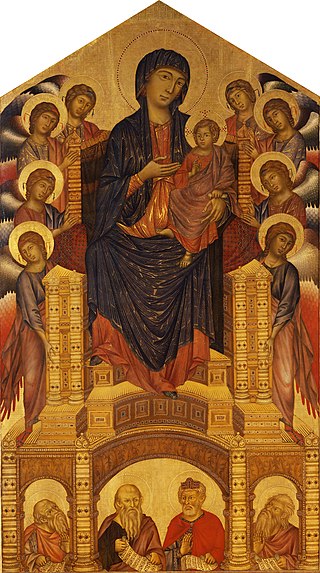
Cimabue, c. 1240 – 1302, was an Italian painter and designer of mosaics from Florence. He was also known as Cenni di Pepo or Cenni di Pepi.

Michelangelo di Lodovico Buonarroti Simoni, known mononymously as Michelangelo, was an Italian sculptor, painter, architect, and poet of the High Renaissance. Born in the Republic of Florence, his work was inspired by models from classical antiquity and had a lasting influence on Western art. Michelangelo's creative abilities and mastery in a range of artistic arenas define him as an archetypal Renaissance man, along with his rival and elder contemporary, Leonardo da Vinci. Given the sheer volume of surviving correspondence, sketches, and reminiscences, Michelangelo is one of the best-documented artists of the 16th century. He was lauded by contemporary biographers as the most accomplished artist of his era.

Giorgio Vasari was an Italian Renaissance painter and architect, who is best known for his work Lives of the Most Excellent Painters, Sculptors, and Architects, considered the ideological foundation of all art-historical writing, and still much cited in modern biographies of the many Italian Renaissance artists he covers, including Leonardo da Vinci and Michelangelo, although he is now regarded as including many factual errors, especially when covering artists from before he was born.

Simone Martini was an Italian painter born in Siena. He was a major figure in the development of early Italian painting and greatly influenced the development of the International Gothic style.

Arnolfo di Cambio was an Italian architect and sculptor of the Duecento, who began as a lead assistant to Nicola Pisano. He is documented as being capomaestro or Head of Works for Florence Cathedral in 1300, and designed the sixth city wall around Florence (1284–1333).

Buonamico di Martino, otherwise known as Buonamico Buffalmacco, was an Italian Renaissance painter who worked in Florence, Bologna, and Pisa. Although none of his known work has survived, he is widely assumed to be the painter of a most influential fresco cycle preserved in the Campo Santo of Pisa, featuring The Three Dead and the Three Living, the Triumph of Death, the Last Judgement, the Hell, and the Thebais.

Jacopo d'Antonio Sansovino was an Italian Renaissance sculptor and architect, best known for his works around the Piazza San Marco in Venice. These are crucial works in the history of Venetian Renaissance architecture. Andrea Palladio, in the Preface to his Quattro Libri was of the opinion that Sansovino's Biblioteca Marciana was the best building erected since Antiquity. Giorgio Vasari uniquely printed his Vita of Sansovino separately.
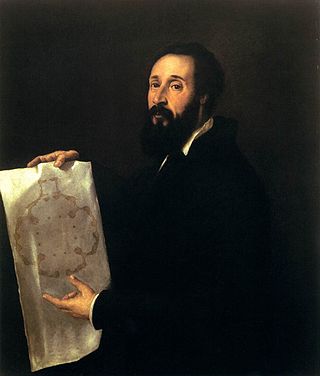
Giulio Pippi, known as Giulio Romano, was an Italian painter and architect. He was a pupil of Raphael, and his stylistic deviations from High Renaissance classicism help define the sixteenth-century style known as Mannerism. Giulio's drawings have long been treasured by collectors; contemporary prints of them engraved by Marcantonio Raimondi were a significant contribution to the spread of sixteenth-century Italian style throughout Europe.
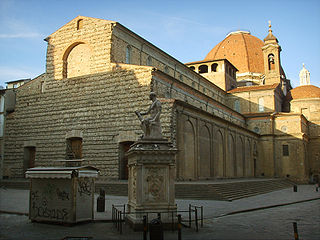
The Basilica di San Lorenzo is one of the largest churches of Florence, Italy, situated at the centre of the main market district of the city, and it is the burial place of all the principal members of the Medici family from Cosimo il Vecchio to Cosimo III. It is one of several churches that claim to be the oldest in Florence, having been consecrated in 393 AD, at which time it stood outside the city walls. For three hundred years it was the city's cathedral, before the official seat of the bishop was transferred to Santa Reparata.

Pisanello, born Antonio di Puccio Pisano or Antonio di Puccio da Cereto, also erroneously called Vittore Pisano by Giorgio Vasari, was one of the most distinguished painters of the early Italian Renaissance and Quattrocento. He was acclaimed by poets such as Guarino da Verona and praised by humanists of his time, who compared him to such illustrious names as Cimabue, Phidias and Praxiteles.

Antonio da Sangallo the Younger, also known as Antonio Cordiani, was an Italian architect active during the Renaissance, mainly in Rome and the Papal States. One of his most popular projects that he worked on designing is St. Peter’s basilica in the Vatican City. He was also an engineer who worked on restoring several buildings. His success was greatly due to his contracts with renowned artists during his time. Sangallo died in Terni, Italy, and was buried in St. Peter’s Basilica.

The Basilica of Saint Francis of Assisi is the mother church of the Roman Catholic Order of Friars Minor Conventual in Assisi, a town in the Umbria region in central Italy, where Saint Francis was born and died. It is a papal minor basilica and one of the most important places of Christian pilgrimage in Italy. With its accompanying friary, Sacro Convento, the basilica is a distinctive landmark to those approaching Assisi. It has been a UNESCO World Heritage Site since 2000.

The Fire in the Borgo is a painting created by the workshop of the Italian Renaissance artist Raphael between 1514 and 1517. Though it is assumed that Raphael did make the designs for the complex composition, the fresco was most likely painted by his assistant Giulio Romano. The painting was part of Raphael's commission to decorate the rooms that are now known as the Stanze di Raffaello, in the Apostolic Palace in the Vatican. It depicts Pope Leo IV halting a fire in 847 with a benediction from a balcony in front of the Old St. Peter's Basilica. The mural lends its name to the Stanza dell'incendio del Borgo.
Various perils are represented in this work. In one part we see a number of women whose hair and clothes are blown about by the terrible fury of the wind as carrying vessels full of water on their heads and in their hands they hurry to put out the fire. There are others bewildered and blinded by the smoke as they try to throw water on the flames. On the other side is depicted an infirm old man, distraught by his weakness and the flames of the fire, being carried by a young man whose face expresses his strength and courage and whose body shows the strain of carrying the figure slumped on his back. He is followed by a dishevelled, bare-footed old woman fleeing from the fire, and going before them is a naked child.
Raffaello da Montelupo, born Raffaele Sinibaldi, was a sculptor and architect of the Italian Renaissance, and an apprentice of Michelangelo. He was the son of another Italian sculptor, Baccio da Montelupo. Both father and son are profiled in Vasari's Le Vite delle più eccellenti pittori, scultori, ed architettori.

The Lives of the Most Excellent Painters, Sculptors, and Architects, often simply known as The Lives, is a series of artist biographies written by 16th-century Italian painter and architect Giorgio Vasari, which is considered "perhaps the most famous, and even today the most-read work of the older literature of art", "some of the Italian Renaissance's most influential writing on art", and "the first important book on art history".
Pagno di Lapo Portigiani was an Italian Renaissance decorative sculptor, a minor follower of Donatello who worked on numerous occasions in projects designed and supervised by Michelozzo.
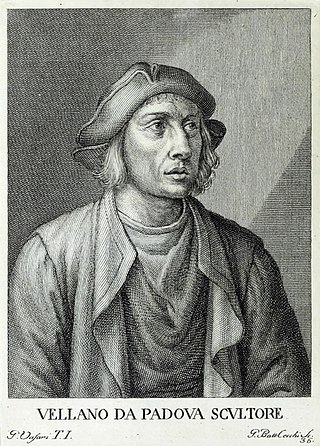
Bartolomeo Bellano, also known as Bartolomeo Vellano, was an Italian Renaissance sculptor and architect who was born in Padua in 1437 or 1438. He was the son of a goldsmith and became a student of the sculptor Donatello, with whom he worked on many projects, including in the Basilica of Saint Anthony of Padua.

Paolo Romano, also known as Paolo Tuccone and as Paolo di Mariano di Tuccio Taccone was an Italian Renaissance sculptor and goldsmith. He was active by 1451, and probably died by 1470. Giorgio Vasari in his Lives of the Most Excellent Painters, Sculptors, and Architects recounts that Paolo Romano was a modest man whose sculpture was far superior to that of his boastful contemporary Mino del Reame.
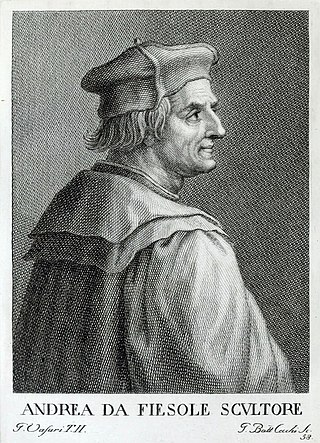
Andrea Ferrucci (1465–1526), also known as Andrea di Piero Ferruzzi and as Andrea da Fiesole, was an Italian sculptor who was born in Fiesole, Tuscany, in 1465. He was a first cousin once removed of the artist Francesco di Simone Ferrucci (1437–1493), under whom he studied.

















